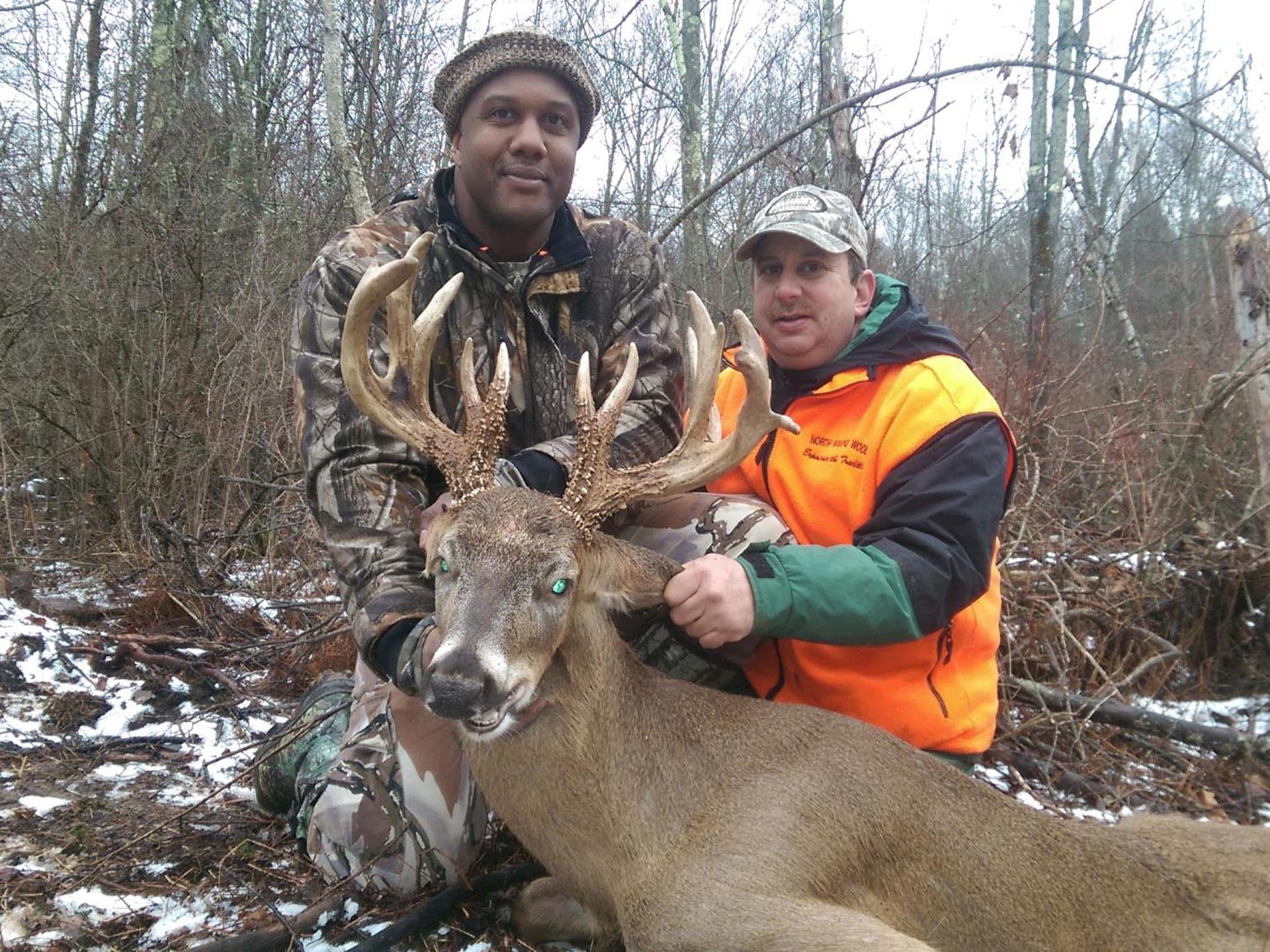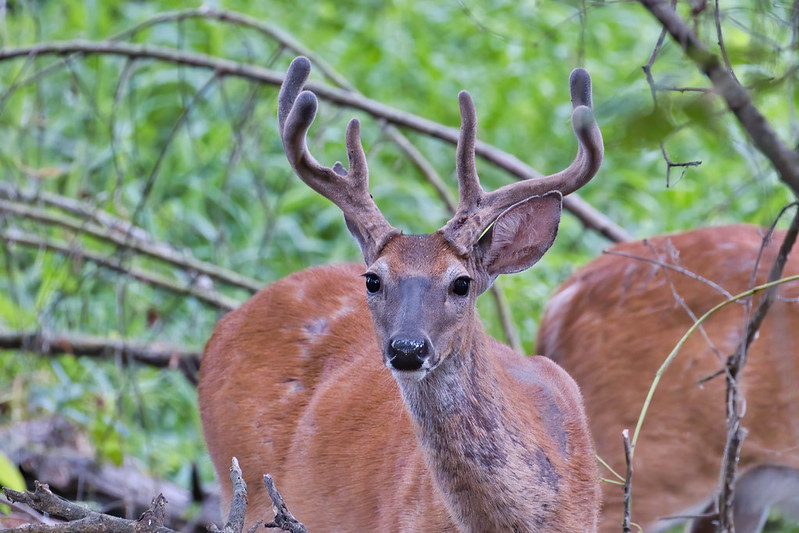
Contents
Tagging a Velvet Whitetail Buck (and the Best States to Do It)
In the past decade, many bowhunters have become obsessed with shooting a whitetail buck in velvet. This pursuit takes place in late August and early September when the temperatures are hot, the ticks are active, and cottonmouths are still a threat. It’s not always enjoyable to be in a treestand during this time, but arrowing a giant buck in velvet is an unforgettable experience.
If you can endure the heat, insects, reptiles, and poison ivy, this hunt will be unlike any other. However, there are a few things you need to know before you head to the deer woods. Your tactics will differ slightly compared to hunting during the rut, and it’s important to know which states have early seasons for targeting velvet bucks. Here’s what you need to know and where to go.
Scout Food Sources to Find Velvet Bucks
The beauty of hunting bucks in velvet is that you can more easily pattern them during this time of year. Some critics claim that hunting a buck in velvet is too easy. While it’s not a simple hunt, the process of patterning is much simpler compared to the following months.
Finding a velvet buck comes down to identifying the food sources the local bachelor bucks are using. Observing from a distance in the evenings will show you exactly where these bachelor groups gather. They will consistently use these same food sources until they are pressured to move on or the food source disappears.
In the South and Midwest, bean fields are the best option. Bucks use these fields in the evening as the temperatures drop and shade covers the area.
Food sources also play a significant role in killing a velvet buck in western states. Hay fields in states like Montana and Wyoming are frequently visited by a large number of deer. Identifying preferred access trails to and from these fields will give you an excellent chance for an early-season whitetail showdown.
What Are Velvet Bucks Eating?
Velvet bucks focus on natural food sources such as acorns, berries, apples, and pears. They also feed on agricultural fields like alfalfa, corn, beans, and milo. Additionally, deer are attracted to oat, cowpea, sunflower, chicory, and clover food plots. During this time of year, bucks try to gain as much weight as possible because they will shed 25 to 30 pounds during the upcoming rut. Therefore, they need to be active feeders. It’s also worth scouting water sources to determine when your target buck drinks. Setting up near water may be more effective than focusing solely on the food source.
Map Your Buck’s Entrance and Exit Routes
Once you’ve found the field that bachelor bucks are using, you need to narrow down where they enter and exit. They usually have multiple access routes, but by observing closely, you can discover their preferences. Pay attention to which trails they use on different wind conditions. Also, take note of any factors that cause them to choose a different route, such as weather, time of day, or thermals. Gathering as much information as possible about the buck you are targeting is key to tagging him on opening day.
Scout in the Morning, Hunt in the Afternoon
For the most part, hunting velvet bucks is an afternoon endeavor. It’s possible to hunt them in the morning if you can reach your treestand without disturbing feeding bucks in the field. During this time of year, bucks often feed at night and then move to cover as daylight approaches. It’s better to observe the bucks from a distance in the mornings and gather as much information as possible. Then, plan to be in your treestand for an evening sit. Slip in undetected in the mid-afternoon and be prepared as soon as the first deer enters the field. Most bucks will be coming out of cool, shaded areas that offer any breeze available, so focus your attention on those areas and hunt as close to them as possible (if wind conditions permit).
Remember, hunting velvet bucks is not an all-day endeavor like hunting during the rut. Avoid sitting in the scorching sun for hours. It’s unlikely a buck will pass by your stand in the middle of the day. They are usually bedded in shaded areas, and you should be there too.

Best States for Killing a Velvet Buck
The provided dates below are for the 2021 season and may change in the future.
Montana
Montana has been a popular destination for whitetail hunters for many years. Depending on the timing of the season opener, you may find a buck still in velvet. With many bowhunters focused on bugling bull elk during this time, there are ample opportunities to tag a velvet buck across the state.
Wyoming
Deer hunts in Wyoming are frequently featured on outdoor TV shows. One common theme is the abundance of white-tailed deer feeding in alfalfa fields. These fields are scarce, but they attract almost every deer in the area. It’s not uncommon to see hundreds of deer in a hay field in the evening. Most of these hotspots are on private land, making Wyoming one of the best places for a guided hunt.
North Dakota
North Dakota was once a hidden gem for deer hunting, but it has gained attention in recent years thanks to outdoor writers and TV coverage. Many bowhunters now travel to the North Dakota plains in search of velvet bucks.
The archery season always starts on the Friday closest to September 1. In some years, the opener is in August, offering an opportunity for a velvet buck. North Dakota has abundant public land for hunting, and hunting on private land is permitted as long as it isn’t posted. It is advisable to obtain landowner permission to show courtesy and potentially gain information about a good buck in the area.
Kentucky
Kentucky has been a top destination for hunting velvet bucks for many hunters east of the Mississippi River. The archery opener dates vary each year, sometimes falling on September 1 and other times a week later. The one-week difference can greatly affect your chances of tagging a velvet buck. Many changes occur during that first week of September. While the majority of bucks are still in full velvet on September 1, that changes by the end of the week. Hard-horned bucks become the norm when the opener is closer to September 7. In Kentucky, baiting is allowed, providing hunters with options beyond waiting for deer on a field edge.
Tennessee
Tennessee offers a newer opportunity to bowhunt a buck in velvet. In recent years, the state created a three-day hunt in late August, one month before the regular season starts, for bowhunters willing to climb into the stand early. This hunt is limited to private lands, with the exception of a few CWD zones that have additional opportunities beyond the statewide hunt.
South Carolina
South Carolina is one of the earliest states in the country to offer deer hunting opportunities. The state is divided into zones, and some regions open for deer hunting as early as August 15. South Carolina may not be known as a trophy whitetail destination, but it has a significant deer population.

A skilled hunter, dedicated conservationist, and advocate for ethical practices. Respected in the hunting community, he balances human activity with environmental preservation.
